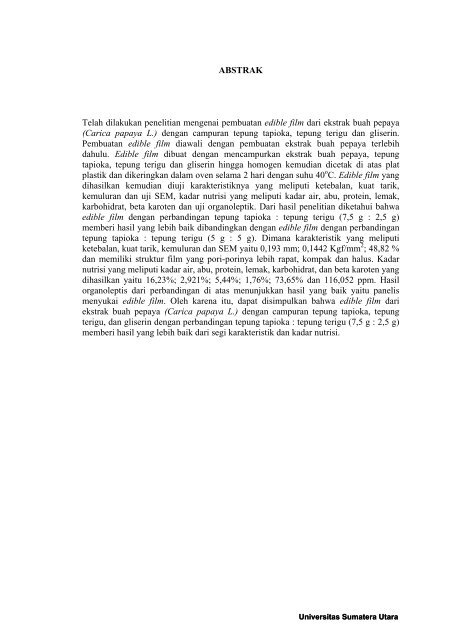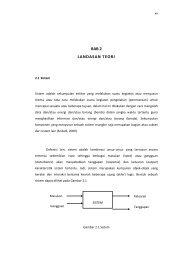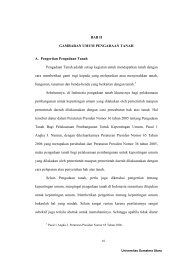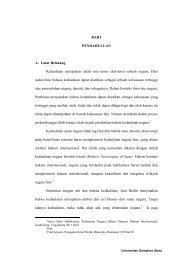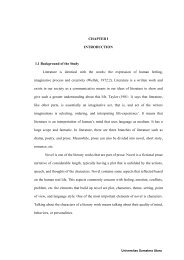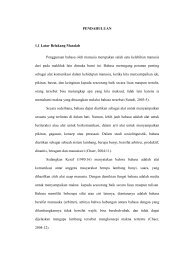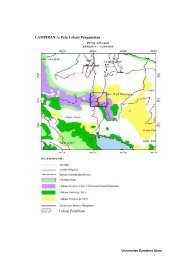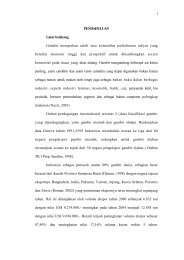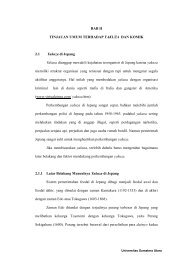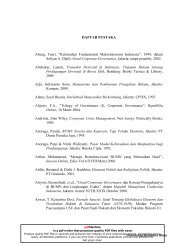(Carica papaya L.) dengan campuran te - USU Institutional ...
(Carica papaya L.) dengan campuran te - USU Institutional ...
(Carica papaya L.) dengan campuran te - USU Institutional ...
You also want an ePaper? Increase the reach of your titles
YUMPU automatically turns print PDFs into web optimized ePapers that Google loves.
ABSTRAK<br />
Telah dilakukan penelitian mengenai pembuatan edible film dari ekstrak buah pepaya<br />
(<strong>Carica</strong> <strong>papaya</strong> L.) <strong>dengan</strong> <strong>campuran</strong> <strong>te</strong>pung tapioka, <strong>te</strong>pung <strong>te</strong>rigu dan gliserin.<br />
Pembuatan edible film diawali <strong>dengan</strong> pembuatan ekstrak buah pepaya <strong>te</strong>rlebih<br />
dahulu. Edible film dibuat <strong>dengan</strong> mencampurkan ekstrak buah pepaya, <strong>te</strong>pung<br />
tapioka, <strong>te</strong>pung <strong>te</strong>rigu dan gliserin hingga homogen kemudian dicetak di atas plat<br />
plastik dan dikeringkan dalam oven selama 2 hari <strong>dengan</strong> suhu 40 o C. Edible film yang<br />
dihasilkan kemudian diuji karak<strong>te</strong>ristiknya yang meliputi ke<strong>te</strong>balan, kuat tarik,<br />
kemuluran dan uji SEM, kadar nutrisi yang meliputi kadar air, abu, pro<strong>te</strong>in, lemak,<br />
karbohidrat, beta karo<strong>te</strong>n dan uji organoleptik. Dari hasil penelitian diketahui bahwa<br />
edible film <strong>dengan</strong> perbandingan <strong>te</strong>pung tapioka : <strong>te</strong>pung <strong>te</strong>rigu (7,5 g : 2,5 g)<br />
memberi hasil yang lebih baik dibandingkan <strong>dengan</strong> edible film <strong>dengan</strong> perbandingan<br />
<strong>te</strong>pung tapioka : <strong>te</strong>pung <strong>te</strong>rigu (5 g : 5 g). Dimana karak<strong>te</strong>ristik yang meliputi<br />
ke<strong>te</strong>balan, kuat tarik, kemuluran dan SEM yaitu 0,193 mm; 0,1442 Kgf/mm 2 ; 48,82 %<br />
dan memiliki struktur film yang pori-porinya lebih rapat, kompak dan halus. Kadar<br />
nutrisi yang meliputi kadar air, abu, pro<strong>te</strong>in, lemak, karbohidrat, dan beta karo<strong>te</strong>n yang<br />
dihasilkan yaitu 16,23%; 2,921%; 5,44%; 1,76%; 73,65% dan 116,052 ppm. Hasil<br />
organoleptis dari perbandingan di atas menunjukkan hasil yang baik yaitu panelis<br />
menyukai edible film. Oleh karena itu, dapat disimpulkan bahwa edible film dari<br />
ekstrak buah pepaya (<strong>Carica</strong> <strong>papaya</strong> L.) <strong>dengan</strong> <strong>campuran</strong> <strong>te</strong>pung tapioka, <strong>te</strong>pung<br />
<strong>te</strong>rigu, dan gliserin <strong>dengan</strong> perbandingan <strong>te</strong>pung tapioka : <strong>te</strong>pung <strong>te</strong>rigu (7,5 g : 2,5 g)<br />
memberi hasil yang lebih baik dari segi karak<strong>te</strong>ristik dan kadar nutrisi.<br />
Universitas Suma<strong>te</strong>ra Utara
MANUFACTURED OF EDIBLE FILM FROM PAPAYA’S EXTRACT (<strong>Carica</strong><br />
<strong>papaya</strong> L.) WITH TAPIOCA, WHEAT AND GLYCERIN MIXTURE<br />
ABSTRACT<br />
Has done research on the manufactured of edible film from <strong>papaya</strong>’s extract (<strong>Carica</strong><br />
<strong>papaya</strong> L.) with tapioca, wheat and glycerin mixture. The making of edible filmmaking<br />
begins with the first extract of <strong>papaya</strong>. Edible film made by mixing <strong>papaya</strong>’s<br />
extract, tapioca, wheat, and glycerin until homogeneous and poured it on the plastic<br />
plat then dried in an oven for 2 days with a <strong>te</strong>mperature of 40 o C. Edible films<br />
produced and then <strong>te</strong>s<strong>te</strong>d the charac<strong>te</strong>ristics that is thickness, <strong>te</strong>ngsile strength, elastic,<br />
and SEM, for nutrient levels that is wa<strong>te</strong>r, ash, pro<strong>te</strong>in, fat, carbohydra<strong>te</strong>s, beta<br />
caro<strong>te</strong>ne, and organoleptic <strong>te</strong>st. Survey results revealed to edible film with comparison<br />
tapioca : wheat (7,5 g : 2,5 g) show good result for edible film with comparison<br />
tapioca : wheat (5 g : 5 g). Where is the charac<strong>te</strong>ristics which include thickness <strong>te</strong>nsile<br />
strength, elastic and SEM that is 0,193 mm; 0,1442 Kgf/mm 2 ; 48,82 % and making a<br />
film with structure that has tight pores, compatible, and smooth. Levels of nutrients<br />
that is wa<strong>te</strong>r, ash, pro<strong>te</strong>in, fat, carbohydra<strong>te</strong>s, and beta caro<strong>te</strong>ne from the edible film<br />
are 16,23%; 2,921%; 5,44%; 1,76%; 73,65% and 116,052 ppm. The results of <strong>te</strong>st<br />
organoleptic from above give a good results that is the panelis like the edible film.<br />
Therefore, the conclusion is edible film from <strong>papaya</strong>’s extract with tapioca, wheat and<br />
glycerin mixture with comparison tapioca : wheat (7,5 g : 2,5 g) give a good result to<br />
charac<strong>te</strong>ristic and level nutriens.<br />
Universitas Suma<strong>te</strong>ra Utara


